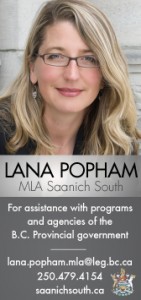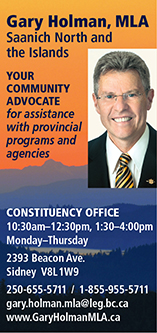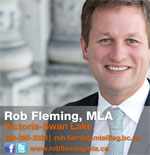TIME FOR A REAL CONVERSATION – Suggests civic educator Mona Brash to Central Saanich
by Sue Stroud
“The last amalgamation in BC was that of Abbotsford and Matsqui to form the City of Abbotsford in 1995,” explained civic educator Mona Brash speaking at the Residents and Ratepayers of Central Saanich Society (RRoCSS) meeting last spring. “Now, some in the newly-formed municipality are expressing concerns about unexpected social problems that arose because of that amalgmation.”
Brash explained that many problems arose from the increase in development that took place following Abbotsford’s amalgamation. The social problems included homelessness, caused by rapid growth and gentrification; and degradation of the area’s natural eco-systems: stream quality was affected, wildlife habitat threatened, tree retention lost.
Brash suggested that a great place to start when considering amalgamation is to consider what local government is, and what purpose it serves. She explained that it is often the civic level of government that is touted as the level of government closest and most directly impacting the daily lives of citizens. It is also the level at which c i t i z e n s have the most input into decision-making and can most easily hold politicians accountable.
Some of the questions that came up during discussion at Brash’s presentation included: “Would Central Saanich lose control over its farmland if it was amalgamated with North Saanich and Sidney? How many councillors would there be and from where? How would a change in councillor/citizen ratio impact local accountability and control? Would reducing 27 councillors to nine reduce local input? Who would such a change benefit?”
Some RRoCSS members expressed concern that it would be easier for developers to pressure councils if the councillors were from areas not impacted by the development. For example councillors from an urban area like Sidney might be less inclined to pay heed to concerns brought forward by citizens of rural Central Saanich where farmland preservation, stream protection and other issues are paramount. The loss of local councillors could equate to some loss of local autonomy and accountability.
Brash suggested that community organizations, like the Ratepayers, are wise to be out in front of the issue of amalgamation, so that special-interest groups from outside the community do not control the agenda. She noted that current BC legislation prohibits the provincial government from imposing amalgamation on local governments.
Brash concluded by suggesting to the Ratepayers that, “Your side on this issue is concerned with what happens to democracy and local control, the ‘yes’ emphasizes policing and other shared services and reduced costs.”
She added, “It’s time to make the ‘yes’ side provide fully documented local examples to prove their case.”
-30-











